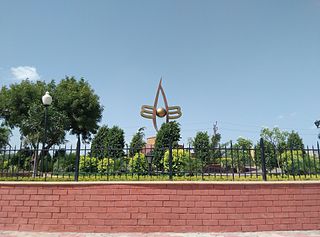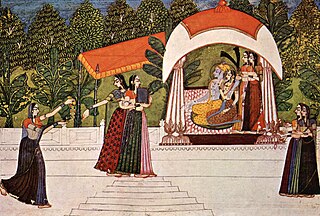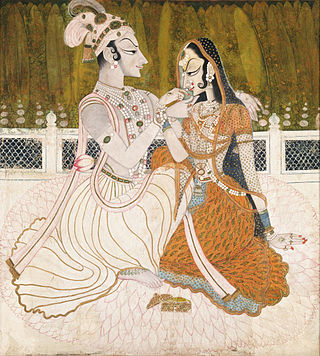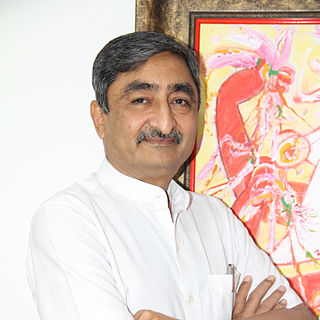
Nathdwara is city of Shreenathji in the Rajsamand district of the state of Rajasthan, India. It is located in the Aravalli hills, on the banks of the Banas River and is 48 kilometres north-east of Udaipur. Shrinathji, is a swarup of lord Krishna which resembles his 7-year-old "infant" incarnation of Krishna. The deity was originally worshiped at Mathura and was shifted in the 1672 from Govardhan hill, near Mathura along holy river Yamuna after being retained at Agra for almost six months. Literally, Nathdwara means 'Gateway to Shrinathji (God)'. Nathdwara is a significant Vaishnavite shrine pertaining to the Pushti Marg or the Vallabh Sampradaya or the Shuddha Advaita founded by Vallabha Acharya, revered mainly by people of Gujarat and Rajasthan, among others. Vitthal Nathji, son of Vallabhacharya institutionalised the worship of Shrinathji at Nathdwara. Today also the Royal king family of Nathdwara belongs to the lineage of vallabhacharya mahaprabhuji. They are called Tilkayat or tikaet of Nathdwara.

Pichhwai, literally meaning 'that which hangs from the back' from the Sanskrit words "Pichh" means back and "wais" means hanging, are large devotional Hindu painted pictures, normally on cloth, which portray Krishna. They are mainly made to hang in Hindu temples of the Pushtimarg devotional tradition, especially the Shrinathji Temple in Nathdwara, Rajasthan, built around 1672. They are hung behind the idol of Shrinathji, a local form of Krishna and the centre of Pushtimarg worship, to depict his leelas. Aurangabad was another area associated with them. The purpose of pichhwais, other than artistic appeal, is to narrate tales of Krishna to the illiterate. Temples have sets with different images, which are changed according to the calendar of festivals celebrating the deity.

Rajput painting, also called Rajasthan painting, evolved and flourished in the royal courts of Rajputana in northern India, mainly during the 17th century. Artists trained in the tradition of the Mughal miniature were dispersed from the imperial Mughal court and developed styles also drawing from local traditions of painting, especially those illustrating the Hindu religious epics, the Mahabharata and Ramayana.

Indian painting has a very long tradition and history in Indian art, though because of the climatic conditions very few early examples survive. The earliest Indian paintings were the rock paintings of prehistoric times, such as the petroglyphs found in places like Bhimbetka rock shelters. Some of the Stone Age rock paintings found among the Bhimbetka rock shelters are approximately 10,000 years old.

VallabhacharyaMahaprabhu, also known as Vallabha, Mahaprabhuji and Vishnuswami, or Vallabha Acharya, is a Hindu Indian saint and philosopher who founded the Krishna-centered PushtiMarg sect of Vaishnavism in the Braj(Vraj) region of India, and the Vedanta philosophy of Shuddha Advaita.

Shrinathji is a form of Krishna, manifested as a seven-year-old child (Balak). The principal shrine of Shrinathji is the Shrinathji Temple in the temple city of Nathdwara, 48 kilometres north-east of Udaipur city in Rajasthan,India. Shrinathji is the central presiding deity of the Vaishnava sect known as Pushtimarg or the Vallabha Sampradaya, established by Vallabhacharya. Shrinathji is worshipped mainly by the followers of Bhakti Yoga and the Vaishnavas in Gujarat and Rajasthan, and Bhatias amongst others.

Pushtimarg, also known as Pushtimarg sampradaya or Vallabha sampradaya, is a subtradition of the Rudra Sampradaya (Vaishnavism). It was founded in the early 16th century by Vallabhacharya (1479–1531) and is focused on Krishna. A bhakti (devotional) school, Pushtimarg was expanded by the descendants of Vallabhacharya, particularly Gusainji. Its values are derived from and its universal-love-themed devotional practices center around the legendary amorous plays of youthful Krishna, such as those found in the Bhagavata Purana and those related to Govardhana Hill. Pushtimarg sampradaya recognizes Krishna by many names and epithets, such as Sri Nathji, Sri Navanitpriyaji, Sri Madanamohanji, Sri Mathureshji, Sri Gokulnathji, Sri Vittalnathji and Sri Dwarkadhishji.

Shuddadvaita is the "purely non-dual" philosophy propounded by Vallabhacharya, the founding philosopher and guru of the Vallabhā sampradāya or Puśtimārg, a Hindu Vaishnava tradition focused on the worship of Krishna. Vallabhacharya's pure form (nondualist) philosophy is different from Advaita. The Shrinathji temple at Nathdwara, and compositions of eight poets, including Surdas, are central to the worship by the followers of the sect.
Bhanwar lal Girdhari lal Sharma, better known as B. G. Sharma, was a painter from Rajasthan, India. He is famous for his miniature devotional paintings and his rejuvenation and popularization of classic Rajasthan art, including the Mughal, Kishangarh, and Kangra styles. He is also well known for experimenting and mixing modern with traditional styles and producing some exemplary pieces of art.

City Palace, Udaipur is a palace complex situated in the city of Udaipur in the Indian state of Rajasthan. It was built over a period of nearly 400 years, with contributions from several rulers of the Mewar dynasty. Its construction began in 1553, started by Maharana Udai Singh II of the Sisodia Rajput family as he shifted his capital from the erstwhile Chittor to the newfound city of Udaipur. The palace is located on the east bank of Lake Pichola and has several palaces built within its complex.

Ragamala paintings are a form of Indian miniature painting, a set of illustrative paintings of the Ragamala or "Garland of Ragas", depicting variations of the Indian musical modes called ragas. They stand as a classical example of the amalgamation of art, poetry and classical music in medieval India.
Rajasthani people or Rajasthanis are a group of Indo-Aryan peoples native to Rajasthan, a state in Northern India. Their language, Rajasthani, is a part of the western group of Indo-Aryan languages.

Patachitra or Pattachitra is a general term for traditional, cloth-based scroll painting, based in the eastern Indian states of Odisha, West Bengal and parts of Bangladesh. Patachitra artform is known for its intricate details as well as mythological narratives and folktales inscribed in it. Pattachitra is one of the ancient artworks of Odisha, originally created for ritual use and as souvenirs for pilgrims to Puri, as well as other temples in Odisha. Patachitras are a component of an ancient Bengali narrative art, originally serving as a visual device during the performance of a song.

Narottam Narayan Sharma was an Indian artist from Nathdwara. He is especially famous for his images of Krishna, which were popular throughout North India and were even more influential than the works of Raja Ravi Varma.

Apart from the architecture of Rajasthan, the most notable forms of the visual art of Rajasthan are architectural sculpture on Hindu and Jain temples in the medieval era, in painting illustrations to religious texts, beginning in the late medieval period, and post-Mughal miniature painting in the Early Modern period, where various different court schools developed, together known as Rajput painting. In both cases, Rajasthani art had many similarities to that of the neighbouring region of Gujarat, the two forming most of the region of "Western India", where artistic styles often developed together.

Shrinathji Temple is a Hindu temple dedicated to Shrinathji in Nathdwara. It is considered an important pilgrimage centre by Vaishnavas.

Anil Relia is an Indian art collector, known for his portrait collection. He has over 3000 portraits and his personal collection includes many miniature paintings, early photographs along with works of artists like Raja Ravi Varma, M. F. Husain, Hemen Majumdar, Bhupen Khakhar, Jyoti Bhatt, Haku Shah, K. G. Subramanyan, S.H. Raza, Thota Vaikuntam, Manu Parekh and many more.

Pundit Devarshi Ramanath Shastri was a Sanskrit poet, scholar and commentator on Pushtimarg and Shuddhadvaita Vedanta, the philosophical school of pure non-dualism propounded by Shri Vallabhacharya (1479-1531). He was born in 1878 in Jaipur, Rajasthan in a renowned Vellanadu Brahmin family of Sanskrit scholars belonging to the Taittariya branch of Krishna Yajurveda, who migrated from Andhra Pradesh to North India in the 15th century AD and to Jaipur in the 18th century with his famous ancestor Kavikalanidhi Devarshi Shrikrishna Bhatt having been invited by Sawai Jai Singh II. His father’s name was Shri Dwarakanath Bhatt and mother’s name was Shrimati Janaki Devi. His only son was Devarshi Brajnath Shastri (1901-1954), who was also a scholar of Shuddhadvaita. He was the elder brother of epoch-making Sanskrit poet and scholar Bhatt Mathuranath Shastri. He wrote extensively in Hindi, Sanskrit and Brajbhasha languages.
Rajaram Sharma is an Indian artist of Pichhwai and Indian miniature paintings.

















